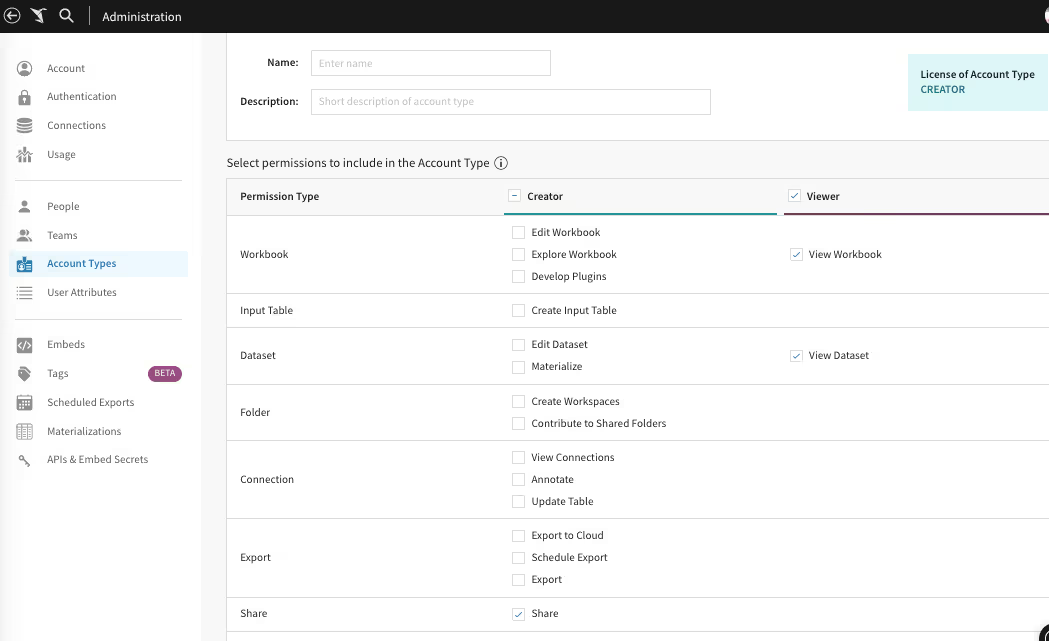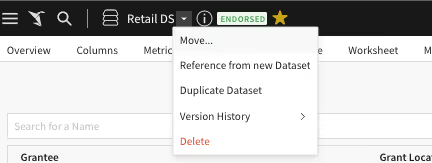Sharing and collaborating on content in Sigma comes with quite a few options. You can share directly with other Sigma users, teams, or move content into a shared workspace where users and teams already have access. Let’s take a look at the options.
Sharing a Workbook with Users and Teams
In order to share content, a user must have a Creator account type with the permission to share box checked.

Permission to access a Sigma document can be shared, modified or revoked by either the individual document’s owner or an organization admin.
Users can share a workbook by selecting the share icon located on the top right corner.

This will open up a modal where you can search and share with a specific user or team in your organization. You can select one of the three options available for sharing: “can view”, “can explore”, or “can edit”.
It’s important to note that a user’s account type will override this. For example, if a user doesn’t have the ability to explore, they will not be able to explore your workbook.

- Can View: Users can view and interact with pre-built assets that have been shared with the. Main permissions include: View, Create a Copy, Send and Schedule Exports.
- Can Explore: Users can explore beyond the limits of what was built for them, allowing them to drill anywhere, create their own calculations, modify charts, etc. They will need to save a copy if they want any of these changes to persist. Main permissions include: All “Can View” permissions, as well as perform analysis in existing workbook (including drill down, add calculations and modify visualizations)
- Can Edit: Users have full ability to create or edit new and existing content. Main permissions include: All “Can View” and “Can Explore” permissions, Edit, Publish, Share, Delete, Move, Rename, and Live Edit.
You can optionally share with a general access link:

Users can also move a workbook into a different folder or workspace by using the workbook dropdown and selecting Move.

Sharing a Dataset with Users and Teams
Users can share a dataset by navigating to the Permissions tab, and selecting Add Permission.

This will open up a modal where you can search and assign permissions to a user or team in your organization. You can select one of the two options available: “can view”, or “can edit”.

Below is a definition of what the different Permission types mean:
- Can View: Users can view the dataset and use it to build other assets, using this as the source. Main permissions include: View, Create a Copy, Send, and Schedule Exports. Datasets can be used as data sources for workbooks or other datasets.
- Can Edit: Users can edit the dataset and publish changes they have made. Main permissions include: All permissions under “Can View”, Edit, Publish, Share, Delete, Move, and Rename.
Users can also move a dataset into a different folder or workspace by using the dataset dropdown and selecting Move.

Sharing With Workspaces
Workspaces allow folders and documents to be compartmentalized, categorized, and easily shared with the correct people. They can be shared amongst users and teams via permission grants.
Workspaces are managed by organization admins. Organization admins have management access to all workspaces within their organization. Admins can also give permission for other users to manage select workspaces or create folders within a workspace. Folders within a workspace basically work like mini-workspaces.

After you have created a workspace, you have the ability to share it with other users and teams and assign the permissions to apply to that workspace. This will open up a modal where you can search and share with a specific user or team in your organization. You can select one of the three options available for sharing: “can view”, “can explore”, “can contribute”, and “can manage”.
It’s important to note that a user’s account type will override this. For example, if a user doesn’t have the ability to explore, they will not be able to explore your workbook.

Below is a definition of what the different Permission types mean:
- Can View: View-only access to documents and folders in the shared space
- Can Explore: Explore access to workbooks in the shared space, view-only access to all datasets in the shared space
- Can Contribute: Create and edit their own docs and folders, view and explore other users’ documents and folders in the shared space. Manage anything they create. Includes deletion, renaming, and moving of their own documents and folders.
- A user with “Can Contribute” access to a workspace automatically gets “Can Edit” access to all documents that they’ve personally created in that workspace. They also get “Can View” access to datasets in the workspace and “Can Explore” access to workbooks in the workspace.
- Can Manage: Create and edit their own documents and folders, edit other’s documents and folders in the shared space, and manage anything in the shared space. Includes access management, sharing, deletion, renaming, and moving of anyone’s documents and folders
- “Can Manage” in a workspace or folder grants “Can Edit” on any docs within that folder
Read more about security and admin within Sigma here.









